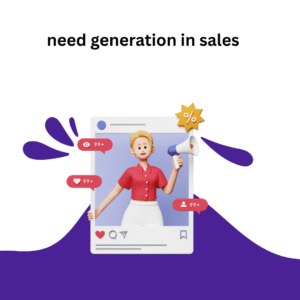Sales are like the heart of any business. Just like your heart pumps blood to keep you alive, sales pump money into a business to keep it going. But to keep sales strong, businesses always need new people to buy their products or services. This is called “lead generation.” It means finding potential customers. Think of it like a treasure hunt! You’re looking for people who might be interested in what you offer. Without new leads, a business can’t grow. It might even shrink. That’s why lead generation is so, so important. It helps businesses find fresh faces. These new faces can become loyal customers. It keeps the business healthy and strong Why Finding New Customers.
Understanding What a “Lead” Is
So, what exactly is a “lead”? Imagine you’re selling lemonade. A lead isn’t just anyone walking by. It’s someone who stops, looks at your stand, and maybe asks a question. They show some interest. In the
business world, a lead is a person or company that shows interest in your product or service. This interest might be small at first. Maybe list to data they clicked on an ad. Or they filled out a form online. It could
also be someone who asked for more information. Leads are not yet customers. But they have the potential to become customers. They’re like clues in our treasure hunt. Each clue brings us closer to a
sale. Knowing who a lead is helps businesses focus their efforts. They don’t waste time on people who aren’t interested.
Why New Leads are Like Fresh Air for Businesses
Think about a car. It needs fuel to run. New leads are like that fuel for a business. They keep it moving forward. Without new leads, sales eventually stop. This means no new money coming in. Businesses
need to grow. Growth means more sales. More sales need more customers. New leads are the start of finding those new customers. They bring new opportunities. They also help businesses replace old
customers. Sometimes, customers move on. Or they don’t need the product anymore. New leads ensure a steady flow of potential buyers. This keeps the business alive and thriving. It also allows
businesses to try new things. They can reach new types of people. This helps them expand their reach.
Different Ways to Find New Leads
There are many ways to find new leads. It’s like having different tools in a toolbox. Some common ways include online marketing. This means using the internet. Businesses can use social media.
They can also run ads on websites. Another way is through content marketing. This involves creating helpful articles or videos. People find understanding the tricks of spam senders these helpful. Then they learn about the business.
Email marketing is also popular. Businesses send emails to people. These emails share information. They might offer special deals. Search engine optimization (SEO) helps too. It
makes websites show up higher in search results. This makes it easier for people to find them. Another old but good method is networking. This means meeting people. Businesses go to events. They talk
to other professionals. They exchange information. Referrals are also very powerful. Happy customers tell their friends. These friends then become new leads. Each method has its own strengths. Businesses often use many methods together. This helps them find lots of new leads.
The Power of Online Lead Generation
Today, the internet is a huge place for finding leads. Most people use the internet every day. So, businesses go where the people are. Websites are like online storefronts. They attract visitors.
Social media platforms are also key. Facebook, Instagram, and TikTok are examples. Businesses share posts there. They interact with people. This creates interest. Online ads can reach many people
quickly. These ads show up on websites. They also mobile lead appear on social media. When someone clicks an ad, they become a lead. Search engines like Google are vital. People search for things they need.
Businesses want to appear in those seare useful information. They show the business is an expert. People trust experts. This builds their interes collect
information. They ask for names and emails. This is how businesses get contact details. The internet makes it easy. It helps businesses find leads around the world.
Converting Leads into Customers: The Next Step
Finding leads is just the first part. The next big step is turning them into customers. This is called “conversion.” Imagine you found the treasure map. Now you need to dig for the treasure. Businesses need to talk to their leads. They might send them more information. They might offer a free trial. Or they might give a special discount. This helps the lead decide to buy. It’s about building trust. Businesses show the lead how their product helps. They answer all questions. They make the buying process easy. This requires good communication. It also needs patience. Not every lead will become a customer. But many will. The goal is to turn as many leads as possible into sales. This completes the sales journey. It makes the lead generation efforts worthwhile.

Measuring Success: Knowing What Works
How do businesses know if their lead generation is working? They measure it. This means keeping track of numbers. They look at how many leads they find. They also see how many of those leads
become customers. This is called the conversion rate. For example, if they get 100 leads and 10 become customers, their conversion rate is 10%. They also track the cost. How much money did it cost
to get each lead? This helps them see if they are spending wisely. They might also look at where leads come from. Is social media working better than email? This data helps them improve. They can put
more effort into what works best. They can stop doing what doesn’t work. Measuring success is like checking a map during the treasure hunt. It tells you if you’re on the right path. It helps you adjust
your route. This makes future lead generation even better. It ensures businesses get the most out of their efforts. It leads to more sales in the long run.
Challenges in Finding New Customers
Finding new customers can be hard. It’s not always easy. One challenge is competition. Many businesses are trying to get the same customers. This means businesses have to stand out. They need
to be unique. Another challenge is finding the right people. Not everyone is a good fit. Businesses need to find people who actually need their product. They also need to reach them. Sometimes, it’s
hard to get noticed. People see many ads every day. They might ignore most of them. This is called
“ad fatigue.” Keeping up with new technologies is also a challenge. The internet changes fast. New social media platforms pop up. Businesses need to learn these new tools. They need to adapt
their strategies. Finally, cost can be a challenge. Some lead generation methods can be expensive. Businesses need to manage their budget. They must get good results for their money. Despite these
challenges, lead generation is still essential. Businesses find ways to overcome them. They learn and adapt.
The Future of Lead Generation
Lead generation is always changing. New tools and ways to connect are appearing. One big trend is personalization. This means making messages special for each person. Instead of a general ad, it’s
tailored. It uses their name. It talks about their specific needs. This makes people feel special. They are more likely to respond. Another trend is using artificial intelligence (AI). AI can help find the best
leads. It can analyze data very fast. It can also help write better messages. Video content is also growing. People love watching videos. Businesses use short videos. They explain their products. They
show how they help. Live events are also coming back. These can be online or in person. They help businesses connect directly. People can ask questions. These new trends make lead generation
exciting. They offer new chances. Businesses that use these trends will do well. They will find even more customers. The future looks bright for finding new customers.
Why You Should Care About Lead Generation (Even if You’re Not in Sales)
Even if you don’t work in sales, lead generation matters. Why? Because it affects everything. When a business finds new customers, it grows. Growth means more jobs. It means better products. It means
more money for the company. This money can be used for new ideas. It can improve things. If a business doesn’t find new leads, it struggles. It might have to cut back. It might even close. This affects
many people. So, lead generation isn’t just a sales thing. It’s a business thing. It’s a vital part of any successful venture. Therefore, it’s a topic everyone can
appreciate. It leads to a vibrant and thriving business world.
